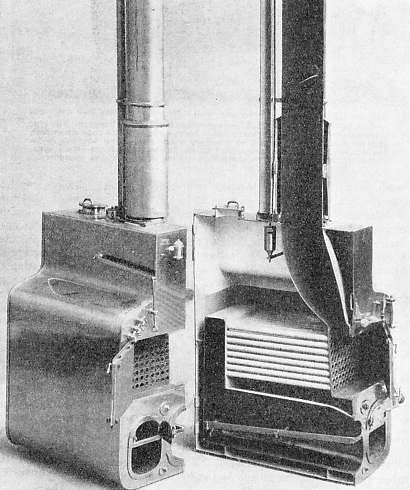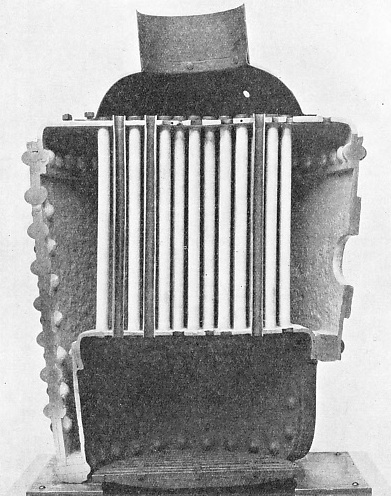

© Shipping Wonders of the World 2012-

Early Marine Boilers
Ships’ boilers at first were built on the lines of early land steam boiler, but before long improvements were incorporated to make the boilers more suitable for marine purposes
MARINE ENGINES AND THEIR STORY -
 FROM a pressure of five pounds a square inch to five hundred pounds -
FROM a pressure of five pounds a square inch to five hundred pounds -
ONE OF THE TUBULAR BOILERS fitted in H.M.S. Janus in 1844, at the suggestion of Thomas Cochrane, tenth Earl of Dundonald. Four boilers were used in H.M.S. Janus, and the model illustrated shows one of them in section with its three furnaces opening into a common combustion chamber at the back of the boiler.
With the adaptation for the requirements of ship propulsion of the steam engine as used on land, the earliest boilers also followed “land” practice. They were generally of the round-
Such boilers were intended for use with steam engines worked by atmospheric pressure. They therefore carried only five or six pounds of steam to the square inch. They were only strong enough to carry the weight of the water they contained and were externally fired. The flues were of brick and sometimes a brick funnel was used such as that in Baird’s steamer, illustrated in the chapter ”Marine Engines and their Story -
The land boiler was soon improved by the use of internal furnace flues, and its application to marine purposes produced the well-
The heating surface was obtained by the provision of large internal flat-
A notable feature of these early box boilers, and one that contributed materially to their success, was the use of copper for their construction, especially in those built for use in warships.
Among other boilers introduced in this early period was the “haystack” type adapted to marine requirements by David Napier in 1842. Napier’s boilers were fitted in a number of early Clyde steamers and were extensively used in small steamships.
The next important development in marine boiler design was the substitution of tubes for the flat flues of the box boilers. Boilers fitted with fire tubes had been used in locomotive practice since the successful trials of George Stephenson’s famous “Rocket” in 1829. The use of tubes for marine boilers was urged by Thomas Cochrane, tenth Earl of Dundonald, who was born in 1775 and died in 1866. The Earl of Dundonald did much to assist the introduction of steam power in the Navy, and he designed HMS Janus, launched in 1844. This warship was equipped with four boilers, each containing three furnaces.
A fine sectional model of one of these boilers may be seen in the Science Museum at South Kensington. The illustration on this page of this model, compared with the other illustrations, gives an excellent impression of marine boiler practice during the past century.
In the boilers of HMS Janus the three furnaces sloped downwards to a common combustion chamber, and from the top part of this compartment a number of tubes was taken through the water space to a smokebox at the front of the boiler. From the smokebox the furnace gases were led to the funnel through a casing or “uptake” passing through the steam space in the boiler.

AN EARLY VERTICAL BOILER was patented in 1881 by G. Kingdon. The type is suitable for high-
This practice was later abandoned as it was found that the plates of such uptakes were subject to rapid deterioration. Subsequently the uptakes were placed outside the boiler fronts. Adjacent flat surfaces were supported by stays, as in the “box” type of boiler with flat flues. “Reverse” valves were fitted to admit air on the formation of a partial vacuum. Other features of these boilers included float-
Experiments were carried out by the Earl of Dundonald in the introduction of hot air into the combustion chambers of his boilers. Box boilers with combustion chambers and fire tubes were in common use in the Royal Navy after 1850 and came into extensive use in the Merchant Service about ten years later. The steam pressure carried in these rectangular boilers was usually about 25 lb to the square inch.
The next development in marine boiler practice is linked with the demand that arose for higher pressures after the general intro-
The transition from the “box” type of boiler to the cylindrical type was not immediate, and between 1862 and 1886 numbers of marine boilers were patented that contained features common to either type. Among such boilers was that patented by W. Hawthorn in 1868. The shell of this boiler was semicircular at the top and bottom and its sides were flat.
There were two oval furnace flues and one oval flue in the centre. The flatter sides of the flues were stayed together. Below the oval flues were three flues of circular section. The front ends of the two outer circular flues were led into an uptake to the funnel. The front ends of the central flues (upper and lower) were joined together. The flues and chambers in the boiler were provided with transverse water tubes that served as strengthening stays and improved the water circulation, in addition to providing additional heating surface. The flames and gases from the furnace flues passed to a combustion chamber at the back of the boiler, then returned through the central oval flue to the front, back through the central circular flue and finally to the front uptakes through the two outer circular flues.
Two boilers of this type, 11 feet long, 9 feet wide and 11 ft 3-
Two important improvements in marine boilers were incorporated in the design patented by W. Gray in 1872. These comprised the means adopted for superheating the steam and for heating the feed water. A boiler of this type consisted of a main cylindrical shell, about 20 feet long and 8 ft 6-
Above the boiler was placed a long steel drum connected to the shell by a number of vertical pipes. This steam drum and the vertical pipes were covered by a saddle-
Another interesting type of boiler was introduced by Howard and Bousefield during 1869 and 1874. In this boiler the single large shell gave place to a number of small drums, each with a diameter of about 42-
In 1877 two important devices were invented for use in boilers. One was S. Fox’s corrugated furnace flue, the other the shell expansion ring patented by G. Hepburn. A circular furnace flue offers great resistance to external pressure so long as it remains truly circular. Should local flattening occur, however, there is a “broken-
The Fox corrugated construction overcomes this difficulty by strengthening the flue, and in addition it gives greater heating surface and provides for longitudinal expansion. For marine boilers the corrugated flue has been the type most extensively used. Early experiments carried out to test the relative strengths of the corrugated flue and of the plain furnace tube showed that the improved form was able to withstand an external hydraulic pressure of 1,020 lb a square inch compared with 225 lb on the unstiffened flue. The Hepburn hoop was introduced into the boiler shell to counteract, by its own elasticity, the stresses due to unequal expansion and contraction of the top and bottom portions of the boiler.
Induced and Forced Draught
Vertical boilers have played their part in steam generation for marine purposes and are still used, although their function now is usually to supply steam to the winches, capstans and auxiliary machinery in cargo vessels. An interesting type is the Cochran boiler, modified for marine use from a land boiler patented in 1878. The vertical shell was fitted with a domed top that served as a steam drum, and the bottom was half-
A type of boiler that closely followed railway locomotive practice and carried a pressure of 120 to 180 lb was at one time used in fast launches and torpedo craft. With horizontal cylindrical shells, these boilers comprised a rectangular water-
The use of surface condensers made it impossible to employ the exhaust blast up the funnel to provide the necessary draught for the fire. This difficulty was overcome by the use of “induced” or “forced” draught.
Where “induced” draught is used the furnace gases are drawn from the smokebox and driven up the funnel by a steam -
Forced draught was introduced in the Royal Navy about 1880 for torpedo vessels and is now used in all warships and to a considerable extent in vessels of the Mercantile Marine.
Chief among cylindrical boilers is the famous “Scotch” boiler, introduced in 1862. These boilers and the further development of marine boilers are described in the chapter ”Modern Marine Boilers”.

THE BURST BOILER of H.M.S. Thunderer, a twin-
You can read more on “Modern Marine Boiler Types”, “Oscillating Paddle Engines” and
“The Queen Mary’s Engines” on this website.